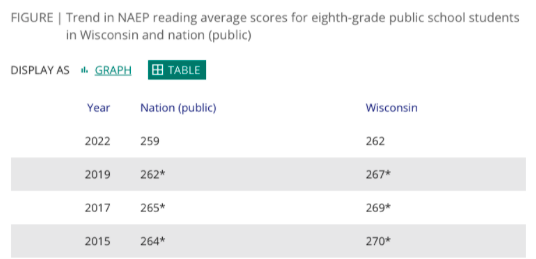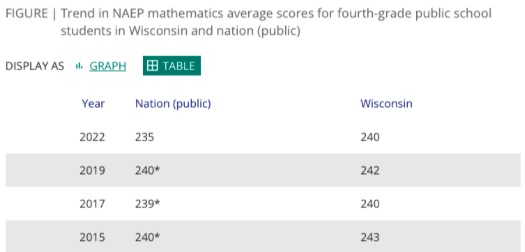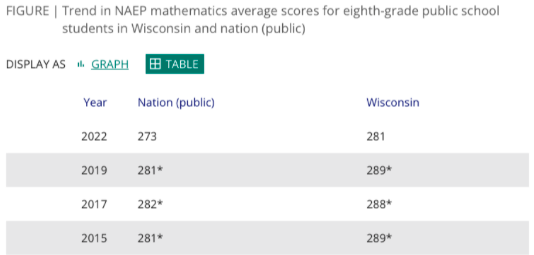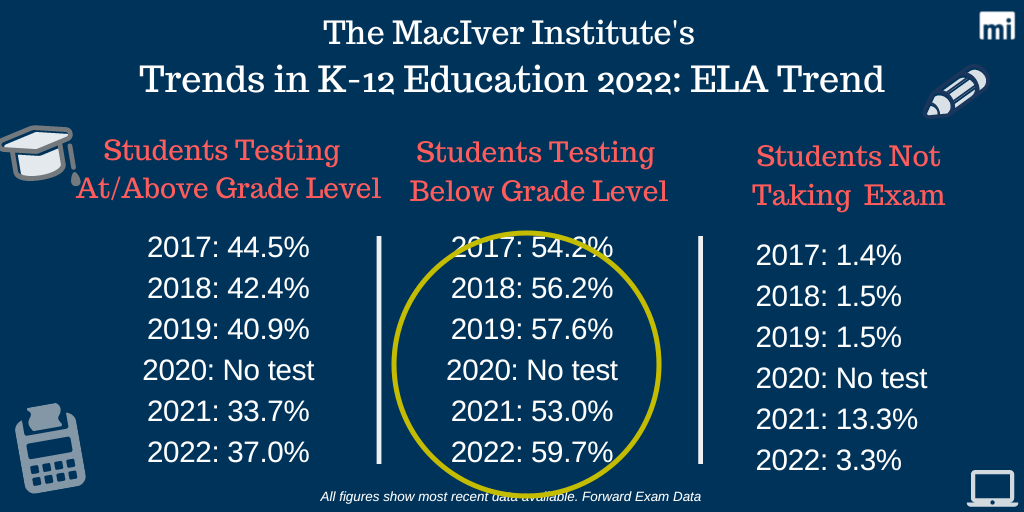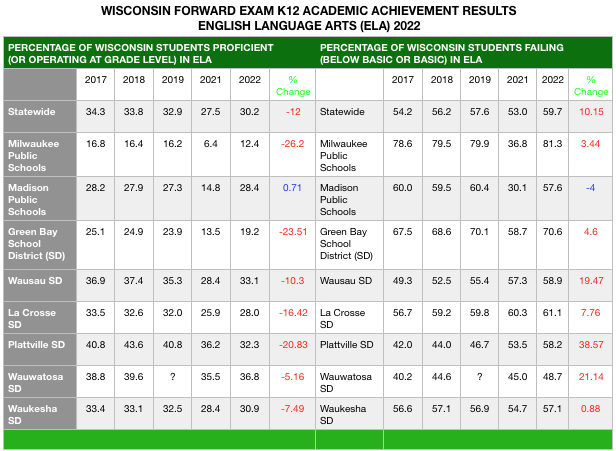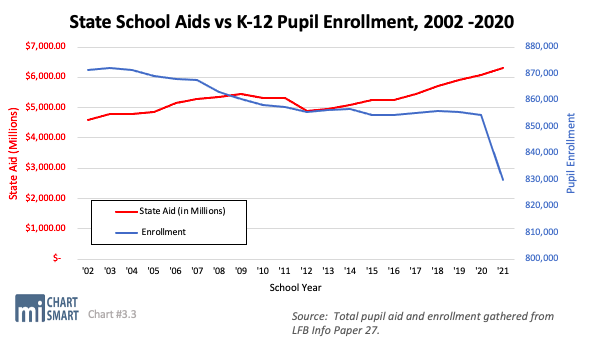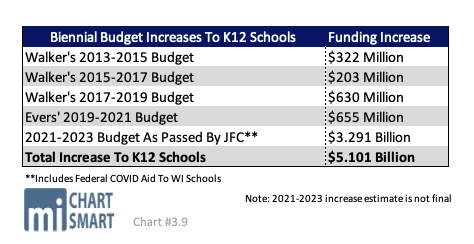
The K12 education crisis across the country and in Wisconsin continues.
Historic drop in math scores.
Wisconsin’s Black-White achievement gap still the worst in the nation.
Remember the unprecedented $130 billion in federal funds supposedly spent to prevent learning loss and get schools to open? It appears that it didn’t work.
Wisconsin children decline in both reading and math.
[bctt tweet=”While the educational establishment will blame the pandemic or say things aren’t so bad because our children generally score higher than the national average, look at how far away our Wisconsin kids are from being proficient.” username=”MacIverWisc”]
The newly released National Assessment of Educational Progress (NAEP) report cards for 4th and 8th-grade students show scores declined in both reading and math compared to 2019. In math, national scores saw the largest decrease ever since the assessment started back in 1990. In reading, national scores “dropped to 1992 levels.”
This release of data was highly anticipated as it is the first after the CDC (Centers For Disease Control) and public health officials across the country closed schools and delayed a return to in-person, teacher-lead instruction after covid hit.
The decline in scores occurred almost universally across the country.
The results come from a statistically representative group of students in each state who took the NAEP exam in the spring of 2022. According to the National Center for Education Statistics, the organization responsible for administering the NAEP test, about 2,200 Wisconsin fourth graders and about 2,600 eighth graders were tested in reading. In math, about 2,300 Wisconsin fourth graders and about 2,500 eighth graders were tested.
The decline in test scores shocked even the education establishment. “I was taken aback by the scope and the magnitude of the decline,” said Peggy Carr, a commissioner of the National Center for Education Statistics.
At the national level, the average reading score declined by 3 points at the 4th-grade level. In 2022, 4th graders scored 217, compared to 220 in 2019. A score of 238 is considered proficient or operating at grade level.
Read that again – a score of 238 is considered proficient or operating at grade level.
For 8th graders nationally, the average reading score declined by 3 points as well. In 2022, 8th graders scored 260, down from 263 in 2019. In 8th grade, a score of 281 is considered proficient or operating at grade level.
The national average math score declined by 5 points at the 4th-grade level. In 2022, 4th graders scored 236, compared to 241 in 2019. A score of 249 is considered proficient or operating at grade level.
The national average math score declined 8 points at the 8th-grade level. In 2022, 8th graders scored 274, compared to 282 in 2019. A score of 299 is considered proficient or operating at grade level. This is the largest decline in NAEP history.
Wisconsin Scores
The academic performance of Wisconsin children declined as well, and the NAEP data mirrors the recent decline in academic achievement scores on the Wisconsin Forward Exam. In Wisconsin, the NAEP average reading score declined by 3 points at the 4th-grade level. In ’22, Wisconsin 4th graders scored 217, compared to 220 in 2019. A score of 238 is considered proficient or operating at grade level.
The percentage of Wisconsin kids failing the 4th-grade reading test increased this year compared to 2019. In 2022, approximately 68% of Wisconsin children scored below basic or basic (failing) on the reading test, and 25% scored proficient (grade level). In 2019, 64% scored below basic or basic.
The Wisconsin average reading score declined 5 points at the 8th-grade level. In 2022, Wisconsin 8th graders scored 262, down from 267 in 2019. A score of 281 is considered proficient or operating at grade level. In 2015, Wisconsin 8th graders scored 270.
The 8th-grade percentage of Wisconsin kids failing the reading test increased as well. In 2022, 67% scored below basic or basic (failing), and 29% scored proficient (grade level). In 2019, 62% scored below basic or basic.
The Wisconsin average math score declined 2 points at the 4th-grade level. In 2022, Wisconsin 4th graders scored 240, down from 242 in 2019. A score of 249 is considered proficient or operating at grade level. In 2015, Wisconsin 4th graders scored 243.
The percentage of Wisconsin kids failing the 4th-grade math test increased this year compared to 2019. In 2022, approximately 57% of Wisconsin children scored below basic or basic (failing) on the math test, and 33% scored proficient (grade level). In 2019, 55% scored below basic or basic.
The Wisconsin average math score declined 8 points at the 8th-grade level. In 2022, Wisconsin 8th graders scored 281, down from 289 in 2019. A score of 299 is considered proficient or operating at grade level. In 2015, Wisconsin 8th graders scored 289.
The percentage of Wisconsin kids failing the 8th-grade math test increased this year compared to 2019. In 2022, approximately 67% of Wisconsin children scored below basic or basic (failing) on the math test, and 25% scored proficient (grade level). In 2019, 58% scored below basic or basic.
It is concerning that the learning loss here in Wisconsin was greater at the 8th-grade level in both subjects. The more time our children are in school, the greater the drop in scores.
While the educational establishment and their friends in the mainstream media will blame the pandemic or say things aren’t so bad because our children generally score higher than the national average, look again (green table) at how far away our Wisconsin kids are from being “proficient.”
Remember, being proficient generally means the child is operating at grade level. GRADE LEVEL. Not advanced. Not doing above average. GRADE LEVEL. The average score for Wisconsin children in reading and math is BELOW PROFICIENT at both grade levels.
These disappointing national numbers track with results of the Wisconsin Forward Exam, the standardized test given only to Wisconsin school children. Just under 60% of our children are failing at English Language Arts (reading), and 58% are failing at math. See the blue “Trends in K12 Education 2022” graphics below.
In Wisconsin, we have 60% of our students in grades 3rd through 10th FAILING these important benchmarks.
Think about that for a second. Where is the outrage?
Despite these abysmal national and state educational achievement numbers, Gov. Evers is running a commercial touting his success in taking Wisconsin schools into the top 10. An honest media would hound the Governor about this “falsehood” until he took down the ad.
Worst Achievement Gap In The Country
Once again, the Wisconsin K12 education system is taking top honors in a dubious category.
Wisconsin is the state with the worst achievement gap, the measure of how Minority students do academically compared to White students, in the nation.
In 4th grade math, White students scored, on average, 248, and Black students scored 201. The gap between the two scores, 48, is second only to Washington, D.C., and up from 37 in 2019. The gap between White students and Hispanic students was 24, ranking the 17th worst in the nation.
In 8th grade math, White students scored, on average, 291, and Black students scored 237, for a difference of 53 points. The gap between White students and Hispanic students at the 8th-grade math level was 27.
In 4th grade reading, White students scored 226, and Black students scored 186, for a difference of 40 points. The achievement gap for this age group is up 1 compared to 2019. The gap between White students and Hispanic students at the 4th-grade reading level was 24.
In 8th grade reading, White students scored 269, and Black students scored 231, for a difference of 38 points. The gap between White students and Hispanic students at the 8th-grade reading level is 19.
The DPI Superintendent back in 2019, Carolyn Stanford Taylor, said at that time that the “persistent achievement gaps are a crisis. Closing these gaps is not only the right thing to do, it is imperative for our state.”
Sadly, neither Stanford Taylor nor her successor, Superintendent Underly, has demonstrated an ability to effectively deal with
“Adequate Funding” Is NOT The Problem
Don’t let your school board or local superintendent tell you the reason for their poor performance is a lack of funding.
The federal government sent at least $130 billion of covid funding to schools to combat learning loss and to make sure schools opened. State government invested an extra $1.2 billion in K12 education in the two state budgets passed before covid hit. This is not a funding problem. This is not a lack of resources problem.
No wonder Superintendent Underly, the official in charge of our children’s education, told the media and the public back in September not to latch onto test scores. She knew how poorly our children are doing academically post-covid, and she wanted to divert attention away from the abject failure of the education establishment.
The problem with poor academic achievement numbers is nothing new in Wisconsin. Yet, even after pumping billions of dollars into the K12 education system in recent years, scores still remain abysmal. This is a huge problem that should not and cannot be ignored or dismissed. This is a moral crisis that we must overcome.
Parents and taxpayers need to stand up, speak out and demand better of our children, our teachers, our administrators, and our elected officials.
Our children are depending on us to fix K12 education.

